Complete Solutions to Illustration of chapter KINEMATICS-2 of Class 11 book with complete answers and questions
| Class 11 | PHYSICS |
| Chapter | KINEMATICS-2 |
| CENGAGE PHYSICS | Illustration |
| Number Of Questions | 76 |
| Academic Year | 2023-24 |
A projectile is fired with a speed u at an angle `theta` with the horizontal. Find its speed when its direction of motion makes an angle `alpha` with the horizontal.
01:48View SolutionWhich of the path (I) or (II) of a projectile has more time of flight ? Use necessary assumptions.
03:13View SolutionA grasshopper can jump upto a height `h` Find the maximum distance through which it can jump along the horizontal ground.
01:23View SolutionThe range of a projectile at an angle `theta` is equal to half of the maximum range if thrown at the same speed. The angel of projection `theta` is given by
01:27View SolutionA batsman deflects a ball by an angle of `45^(@)` without changing its initial speed which is equal to `54 km/h` . What is the impulse imparted to the ball ? ( Mass of the ball is 0.15 kg)
04:44View SolutionThe horizontal range of a projectile is `2 sqrt(3)` times its maximum height. Find the angle of projection.
01:40View SolutionA bulley with muzzle velocity `100 m s^-1` is to be shot at a target `30 m` away in the same horizontal line. How high above the target must the rifle be aimed so that the bullet will hit the target ?
 .02:51View Solution
.02:51View SolutionTwo particles `A and B` are projected from the same point in different directions in such a manner that vertical components of their initial velocities are same (Fig. 5.8). Find the ratio of range.
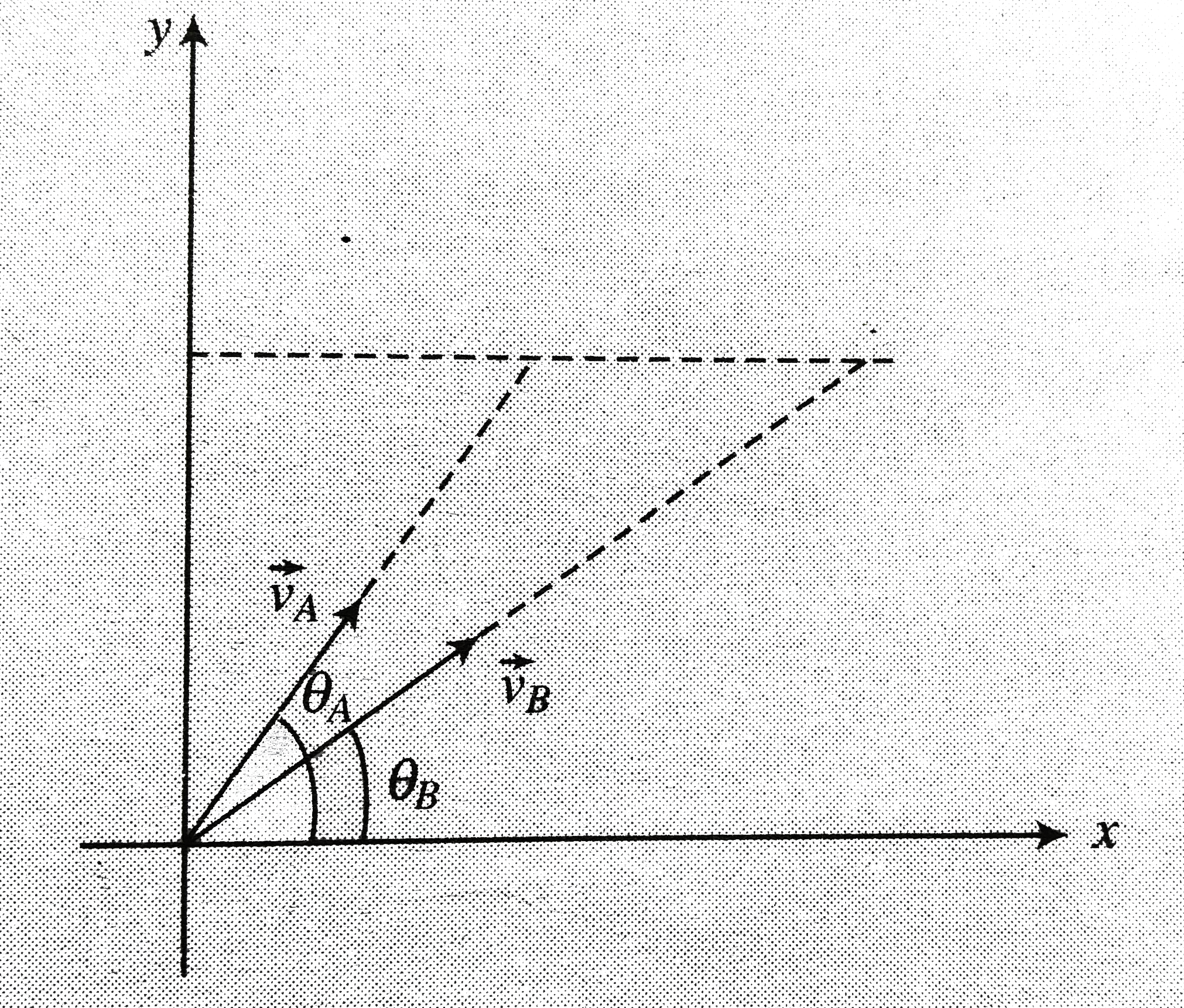 .01:55View Solution
.01:55View SolutionFour cannon balls, `(1),(2),(3), and (4)` are fired from level ground. Cannon ball (1) is fired at an angle of `60^@` above the horizontal and follows the path shown in (Fig. 5.9).
 .
.
Cannon balls (2) and (3) are fired at angle of `45^@` and (4) is fired at an angle of `30^@` above the horozontal. Which cannon ball has the largest initial speed ?05:14View SolutionIn this given reactions,

X and Y are respectively09:23View Solution(Figure 5.11) shows two positions `A and B` at the same height `h` above the ground. If the maximum height os the projectile is `H`, then determine the time `t` elapses between the positions `A and B` in terms of `H`.
 .04:47View Solution
.04:47View SolutionA jet of water is projected at an angle `theta = 45^@` with horizontal from point `A` which is situated at a distance `x = OA = (a) 1//2 m, (b) 2 m` from a vertical wall. If the speed of projection is `v_0 = sqrt(10 ms^-1`, find point `P` of strinking of the water jet with the vertical wall.
 .01:42View Solution
.01:42View SolutionA particle is projected from the ground at `t = 0` so that on its way it just clears two vertical walls of equal height on the ground. The particle was projected with initial velocity `u` and at angle `theta` with the horiozontal. If the particle passes just grazing top of the wall at time `t = t_1 and t = t_2`, then calculate.
(a) the height of the wall.
(b) the time `t_1 and t_2` in terms of height of the wall.
Write the expression for calculating the range of this projectile and separation between the walls.07:07View SolutionFrom a point on the ground at a distance `a` from the foot of a pole, a ball is thrown at an angle of `45^@`, which just touches the top of the pole and strikes the ground at a distance of `b`, on the outer side of it. Find the height of the pole.
05:31View SolutionA particle is thrown over a triangle from one end of a horizontal base and after grazing the vertex falls on the other end of the base. If `alpha and beta` be the base angles and `theta` the angle of projection, prove that `tan theta = tan alpha + tan beta` .
04:18View SolutionA particle projected atv a definite angle `prop` to the horizontal passes through points `(a,b) and (b,a)`, referred to horizontal and vertical axes through the points of projection. Show that :
(a) The horizontal range `R = (a^2 + ab + b^2)/(a + b)` .
(b) The angle of projection `prop` is given by
`tan^-1 [(a^2 + ab + b^2)/(ab)]`.10:32View SolutionA rubber ball escapes from the horizontal roof with a velocity `v = 5 m s^-1`. The roof is situated at a height, `h = 20 m`. If the length of each car is equal to `x_0 = 4 m`, with which car will the ball hit ?
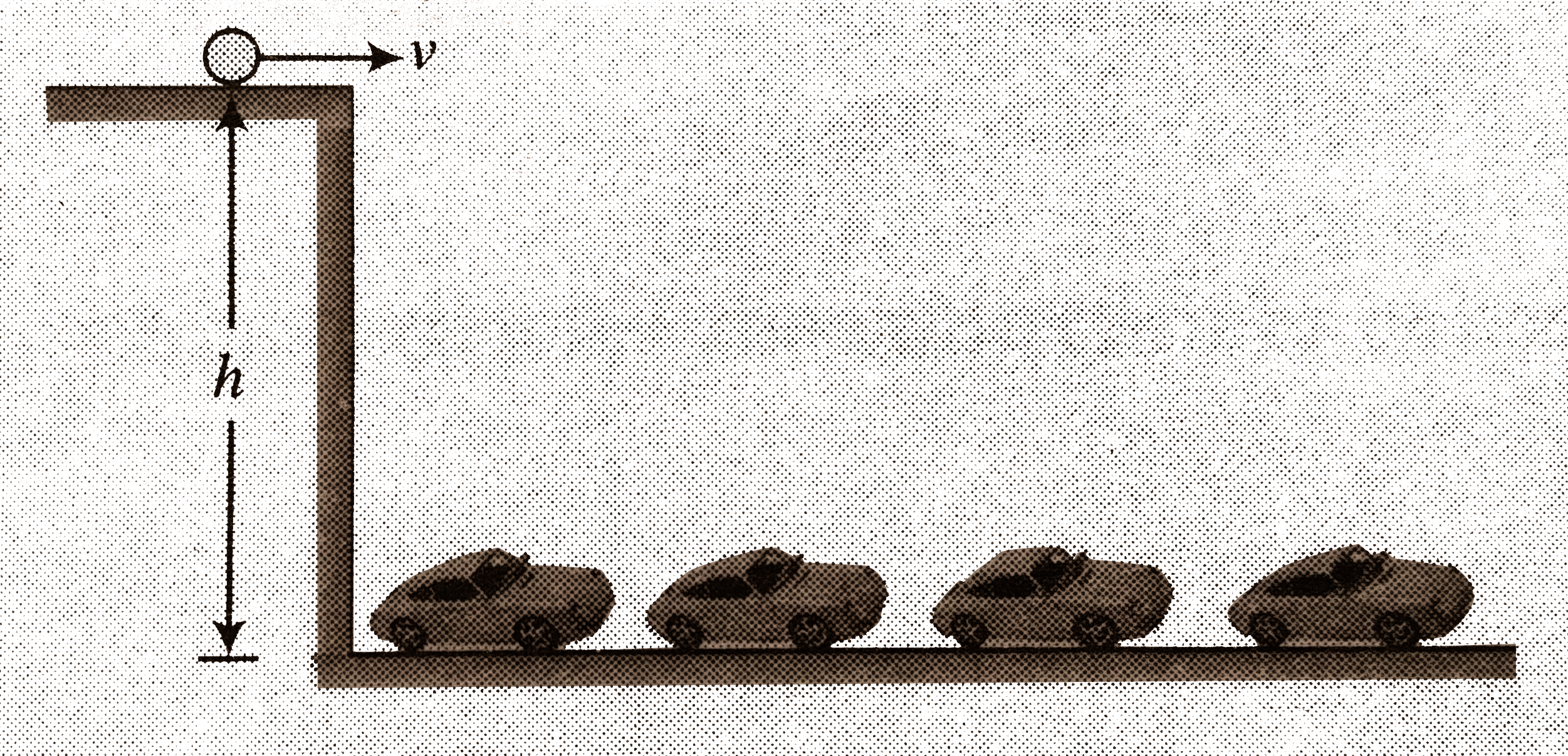 .04:57View Solution
.04:57View Solution(a) With what velocity `(v_0)` should a ball be projected horizontally from the top of a tower so that the horizontal distance on the ground is `eta H`, where `H` is the height of the tower ?
(b) Also determine the speed of the ball when it reaches the ground.
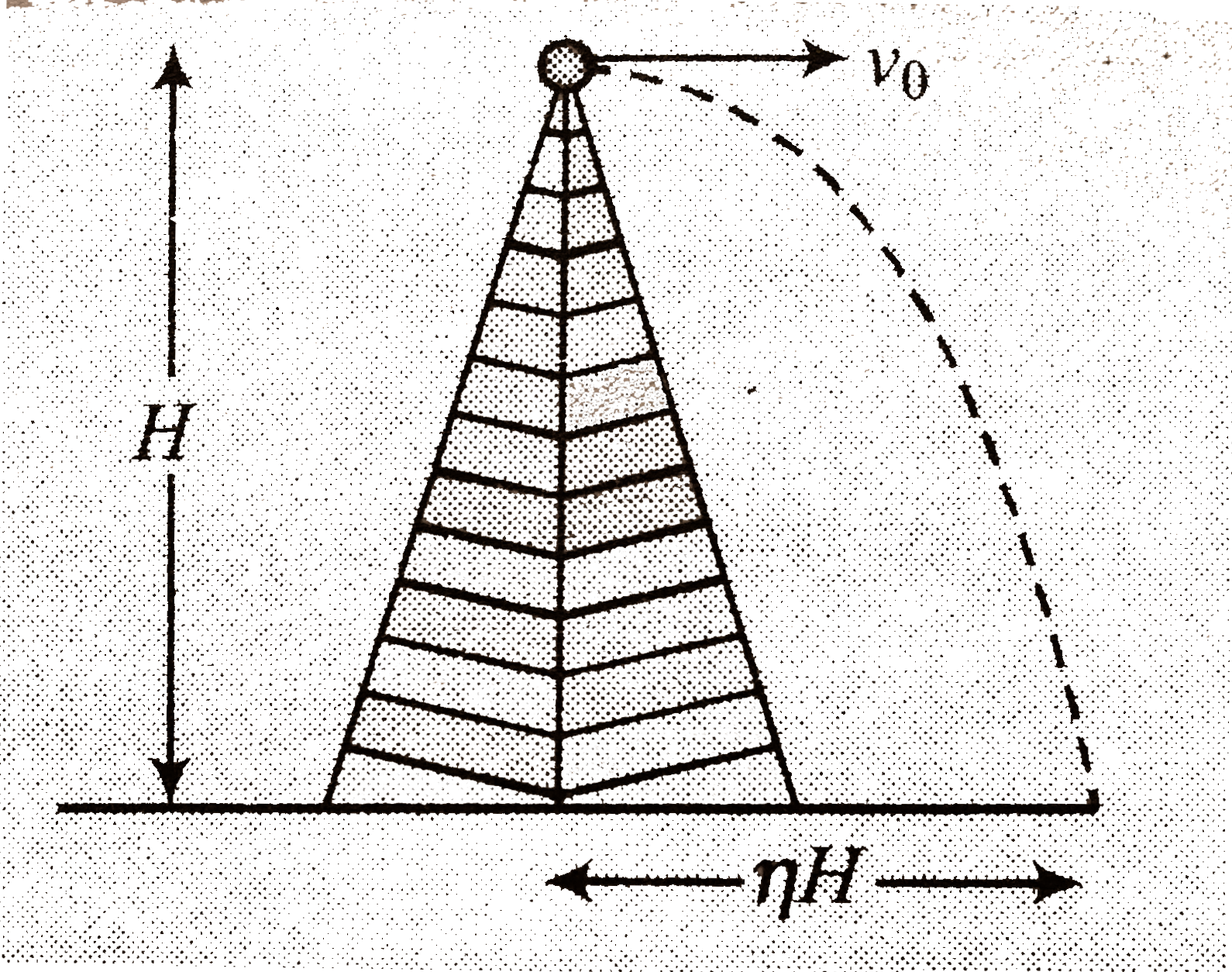 .08:01View Solution
.08:01View SolutionA relief food package is dropped from a airplane which is moving horizontal with a velocity of `30 m s^-1` at a height `h = 50 m`. Find the (a) time of flight of the package, (b) location of the point of striking of the food package, (c ) velocity of the package at the time of striking the ground, and (d) displacement of the food package.
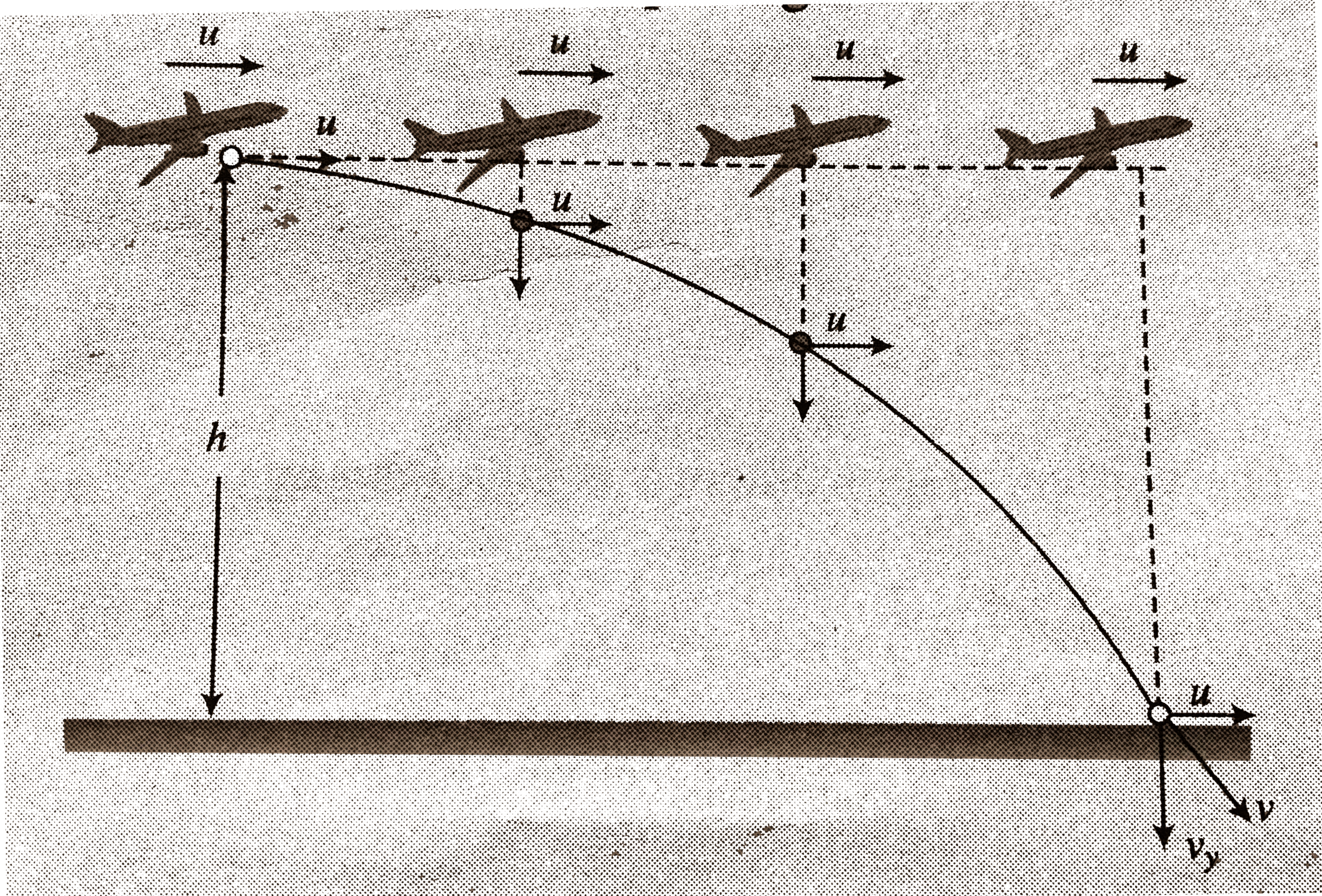 .03:51View Solution
.03:51View SolutionA ball is thrown from the top of a building `45 m` high with a speed `20 m s^-1` above the horizontal at an angle of `30^@`. Find
(a) The time taken by the ball to reach the ground.
(b) The speed of ball just before it touches the ground.03:34View SolutionA boy of height `1.5 m`, making move on a skateboard due east with velocity `4 m s^-1`, throws a coin vertically up a velocity of `3 m s^-1` relative to himself.
(a) Find the total displacement of the coin relative to ground till it comes to the hand of the boy.
(b) What isthe maximum height attained by the coin w.r.t. to ground ?03:18View SolutionA shell is projected from a gun with a muzzle velocity, `u`. The gun is fitted with a trolly car at an angle `theta` as shown in (Fig. 5.33). If the trolley car is made to move with constant velocity `v` towards right, find the
(a) horizontal range of the shell relative to ground.
(b) horizontal range of the shell relative to a person travelling with trolley.
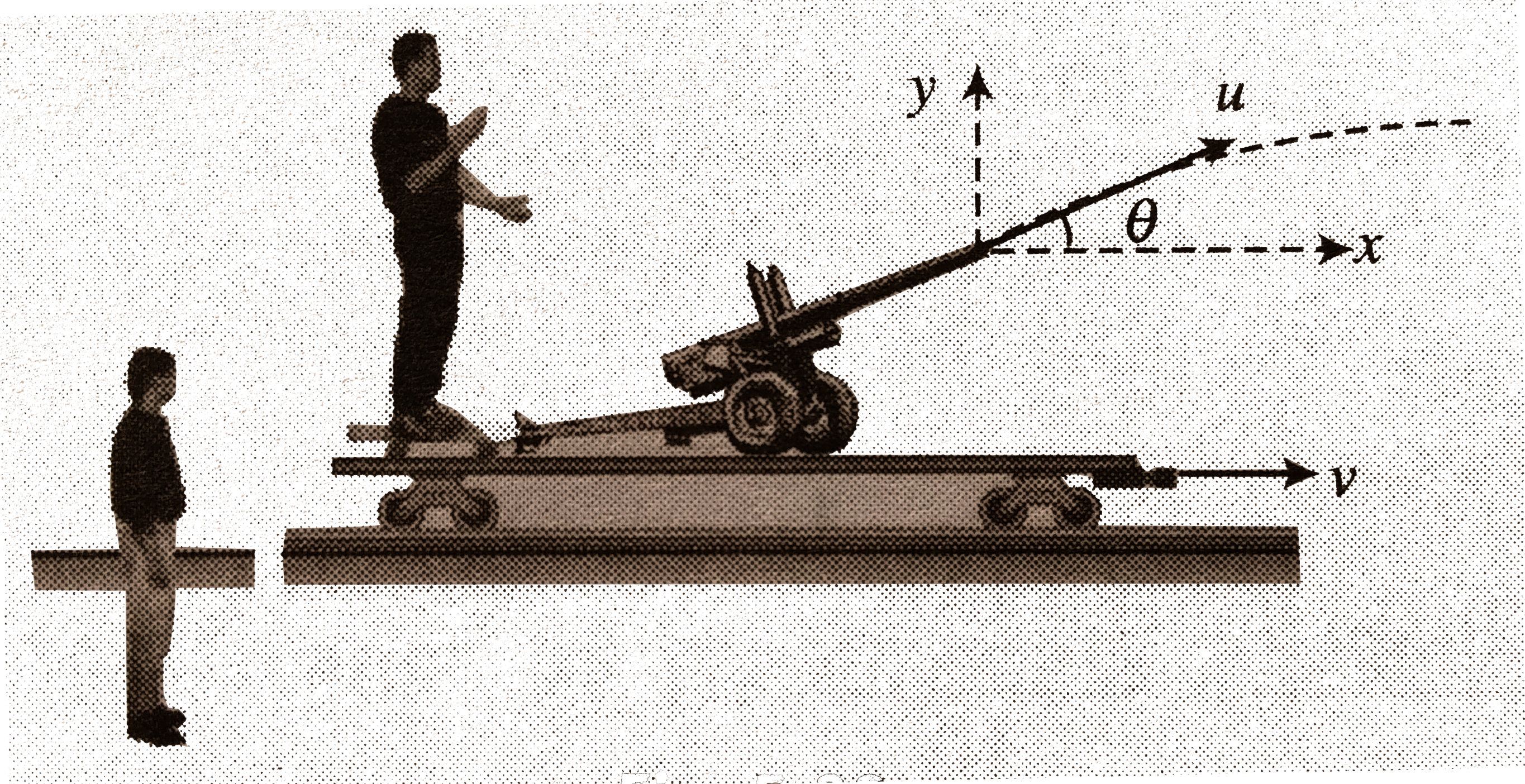 .07:47View Solution
.07:47View SolutionA man is standing on a rail road car travelling with a constant speed of `v = 10 ms^-1` (Fig . 5.34). He wishes to throw a ball through a stationary hoop `5 m` above the height of his hands in such a manner that the ball will move horizontally as it passes through the hoop. He throws the ball with a speed of `12.5 ms^-1` w.r.t. himself.
(a) What must be the vertical component of the initial velocity of the ball ?
(b) How many seconds after he releases the ball will it pass through the hoop ?
( c) At what horizontal distance in front of the loop must he release the ball ?
 .15:15View Solution
.15:15View SolutionA person is standing on a truck moving with a constant velocity of 14.7 m/s o a hrozontal road. The man throws a ball in such a way that it returns to the truck after the truck has moved 58.8 m. Find the speed and the angle of projection. a. as seen from the truck b. as seen fromt the road.
05:06View SolutionA particle is projected with velocity u at angle `theta` with horizontal. Find the time when velocity vector is perpendicular to initial velocity vector.
05:09View SolutionTwo inclined planes OA and OB having inclinations `30^@` and `60^@` with the horizontal respectively intersect each other at O, as shown in figure. A particle is projected from point P with velocity `u=10 sqrt(3) m//s` along a direction perpendicular to plane OA. If the particle strikes plane OB perpendicular at Q. Calculate.
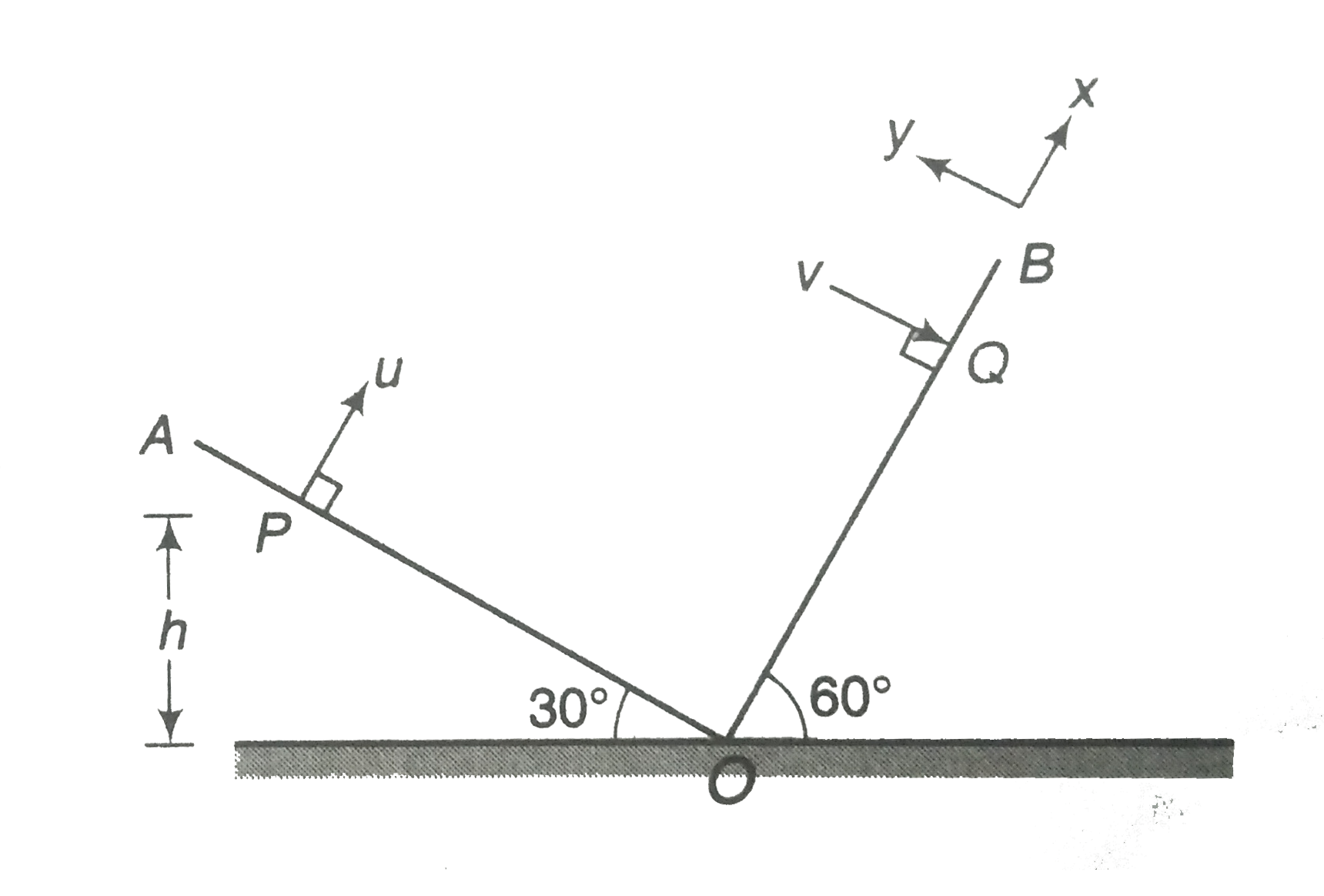
(a) time of flight,
(b) velocity with which the particle strikes the plane OB,
(c) height h of point P from point O,
(d) distance PQ. (Take `g=10m//s^(2)`)07:18View SolutionA truck starts from rest and accelerates uniformly at `2.0 ms^(-2)` . At t = 10 s , a stone is dropped by a person standing on the top of the truck ( 6 m high from the ground). What are th (a) velcity , and (b) acceleration of the stone at t = 11 s ? (Neglect air resistance ).
06:23View SolutionA body is thrown at an angle `theta_0` with the horizontal such that it attains a speed equal to `sqrt((2)/(3))` times the speed of projection when the body is at half of its maximum height. Find the angle `theta_0`.
03:36View SolutionA particle is projected at an angle of elevation `alpha` and after t second it appears to have an elevation of `beta` as seen from the point of projection. Find the initial velocity of projection.
05:24View SolutionAt what angle should a ball be projected up an inclined plane with a velocity `v_0` so that it may hit the incline normally. The angle of the inclined plane with the horizontal is `prop`.
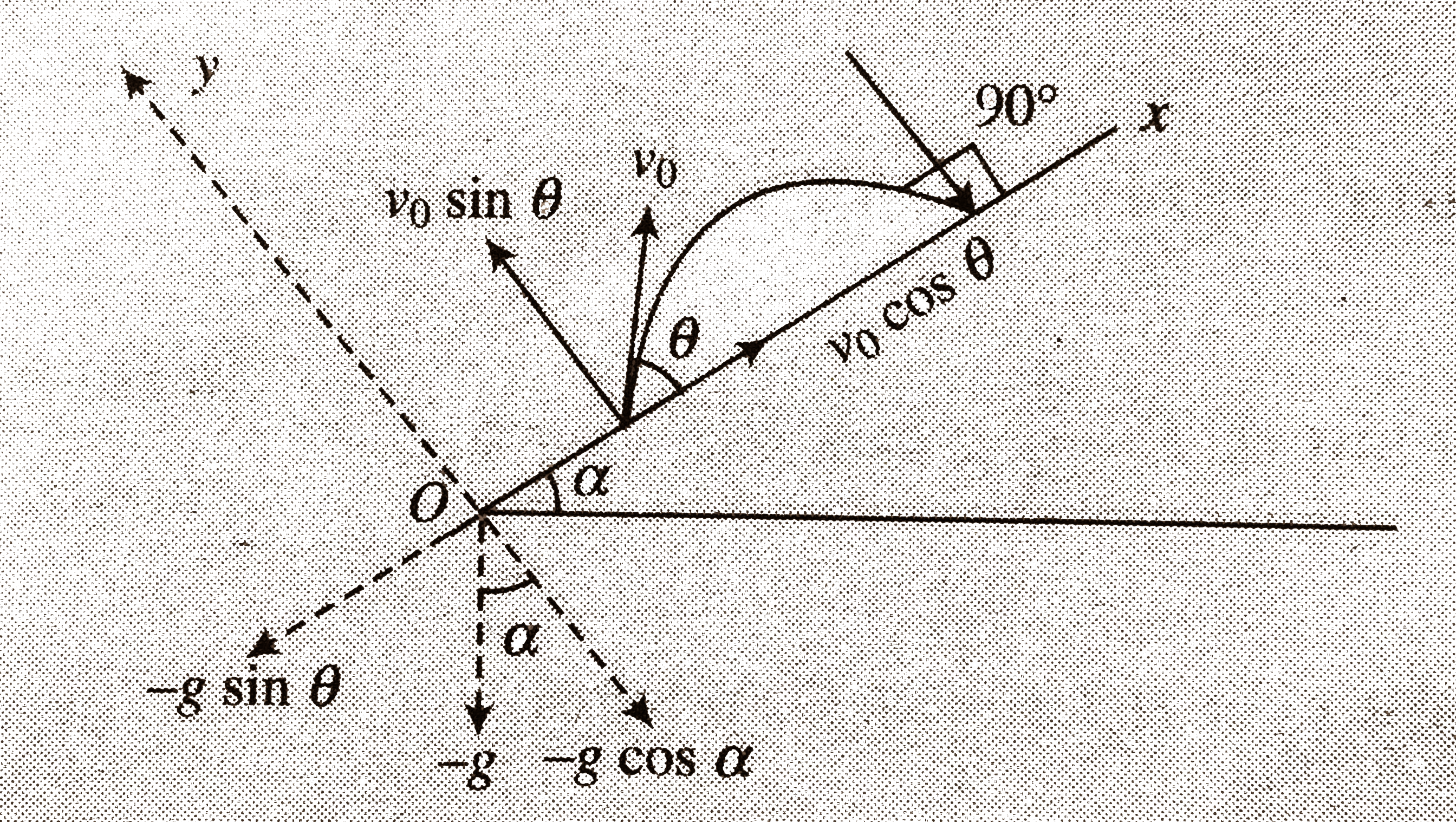 .03:03View Solution
.03:03View SolutionA body is projected up with a speed `v_0` along the line of greatest slope of an inclined plane of angle of inclination `beta`. If the body collides elastically perpendicular to the inclined plane, find the time after which the body passes through its point of projection.
05:54View SolutionAn inclined plane makes an angle `theta_0 = 30^@` with the horizontal. A particle is projected from this plane with a speed of `5 ms^-1` at an angle of elevation `beta = 30^@` with the horizontal as shown in (Fig. 5.53).
(a) Find the range of the particle on the plane when it strikes the plane.
(b) Find the range of the particle for `beta = 120^@`.
 .09:13View Solution
.09:13View SolutionA body has maximum range `R_1` when projected up the plane. The same body when projected down the inclined plane, it has maximum range `R_2`. Find the maximum horizontal range. Assume equal speed of projection in each case and the body is projected onto the inclined plane in the line of the greatest slope.
03:24View SolutionTwo roads interest at right angle , one goes along the x - axis, another along the y - axis. At any instant, two cars `A bad B` moving along `y and x` directions, respectively, meet at intersection. Draw the direction of the motion of car `A` as seen from car `B`.
 .02:59View Solution
.02:59View SolutionTwo roads one , along the y - axis and another along a direction at angle `theta` with x - axis, are as shown in (Fig. 5.68). Two cars `A and B` are moving along the roads. Considerthe situation of the diagram. Draw the direction of
(a) Car `B` as seen from car `A`.
(b) Car `A` as seen car `B`.
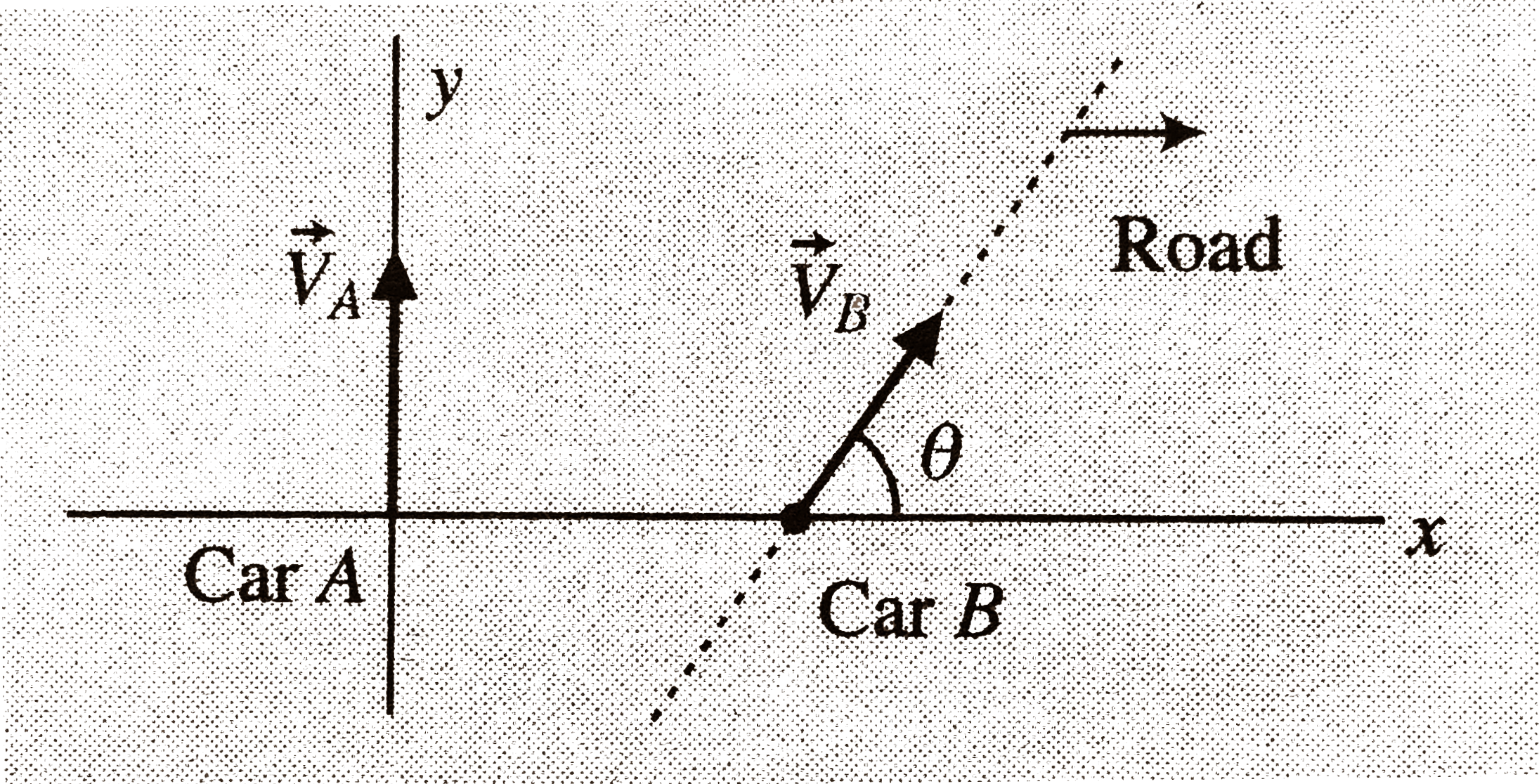 .03:42View Solution
.03:42View SolutionConsider the situation given in (Fig. 5.71). Two cars are moving along road `1` and `2`. Draw the direction of the motion of
(a) Car `B` as seen from car `A`.
(b) Car `A` as seen from car `B`.
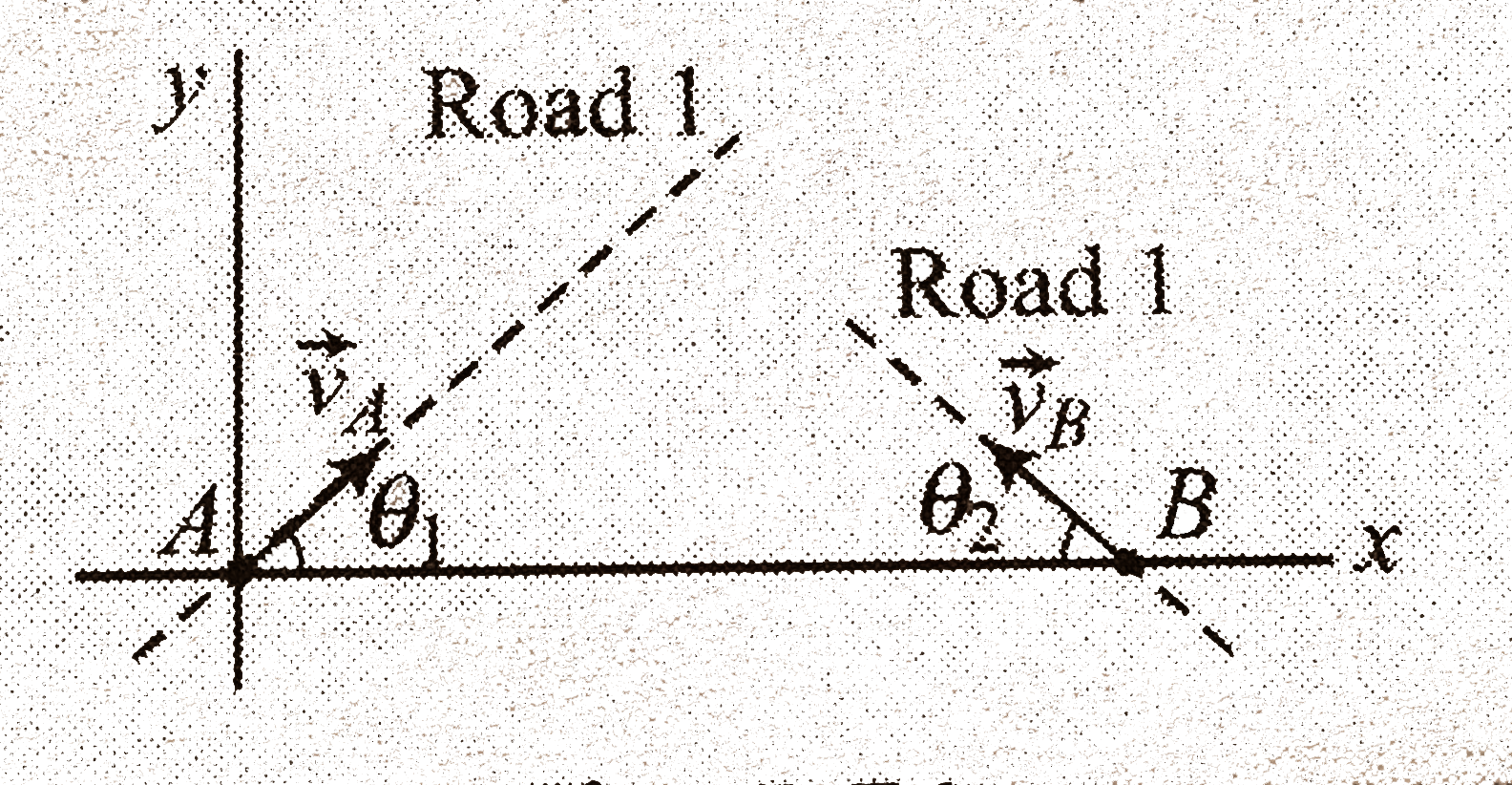 .03:43View Solution
.03:43View SolutionA man `A` is sitting in a car at rest observes a man `B` on bike moving away from him with velocity `16 m s^-1`, a man `C` walking on road with velocity `2 ms^-1` towards him and a bird flying with spedd `20 ms^-1` at angle `37^@` with horizontal as shown in (Fig. 5.74). Find the
(a) velocity of car, bird, and man `C` as seen by man `B`.
(b) velocity of car, bird, man `B` as seen by man `C`
( c) velocity of car, man `B`, and man `C` as seen by bird.
 .09:37View Solution
.09:37View SolutionRam Shyam are walking on two perpendicular tracks with speed `3ms^(-1)` and `4 ms^(-1)`, respectively. At a certain moment `( t = 0s)`, Ram and Shyam are at 20 m and 40 m away from the intersection of tracks, respectively, and moving towards the intersection of the tracks.
During the motion the magnitude of velocity of ram with respect to Shyam is03:17View SolutionTwo objects `A and B` are moving along the directions as shown in (Fig. 5.77). Find the magnitude and direction of the relative velocity of `B w.r.t. A`.
 , 04:48View Solution
, 04:48View SolutionA block slips along an incline of a wedge. Due to the reaction of the block on the wedge, it slips backwards. An observer on the wedge will see the block moving straight down the incline. Discuss how to find the absolute velocity of the block.
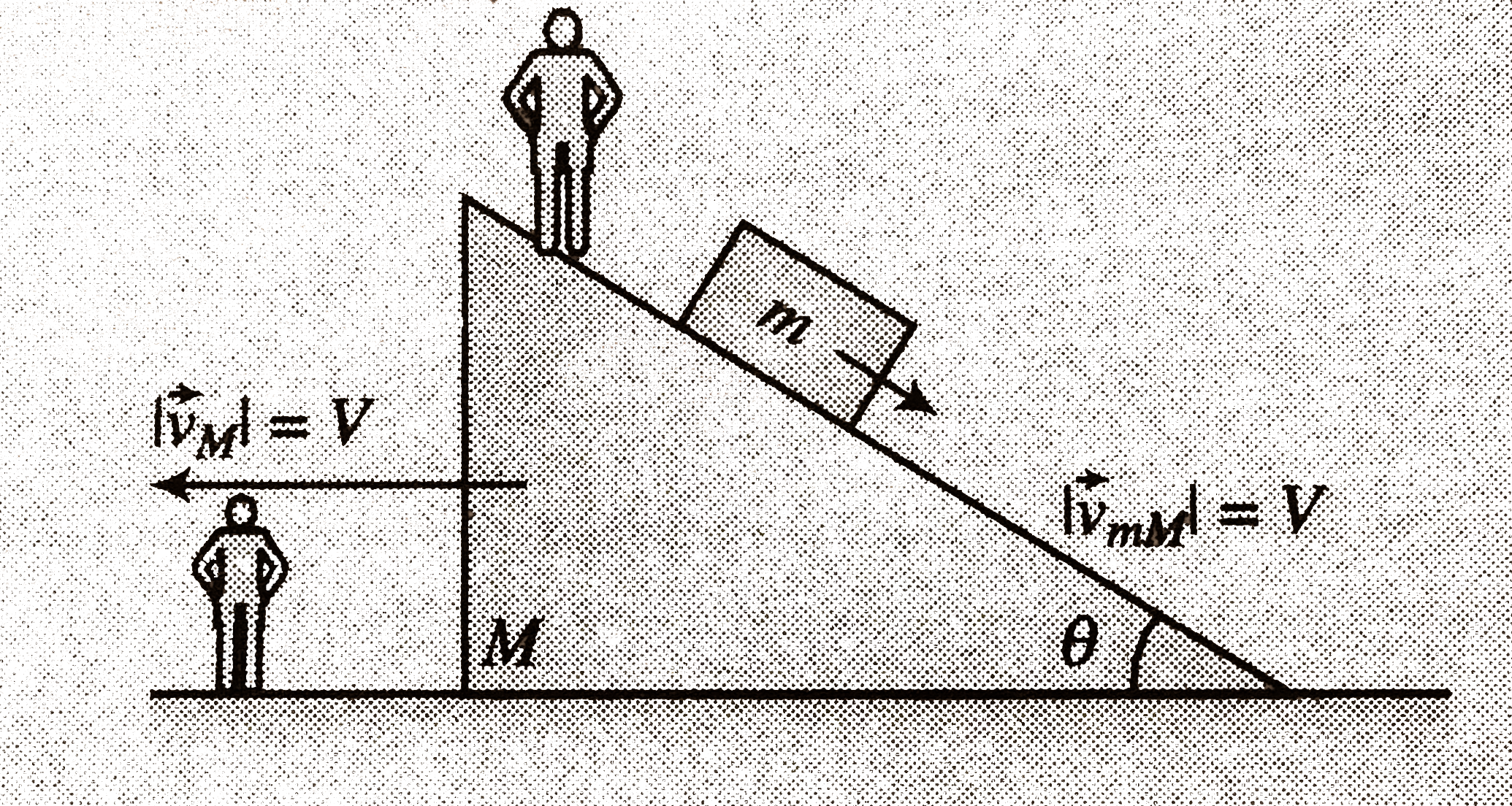 .03:03View Solution
.03:03View SolutionA political party has to start its procession in an area where wind is blowing at a speed of `30 sqrt(2) km h^-1` and party flags on the cars are fluttering along north - east direction. If the procession starts with a speed of `40 km h^-1` towards north, find the direction of flags on the cars.
03:23View SolutionA bird is fying due east with a velocity of `4 m s^-1`. The starts to blow with a velocity of `3 ms^-1` due north. What is the magnituide of relative velocity of bird w.r.t. wind ? Find out its direction also.
04:01View SolutionA truck is moving with a constant velocity of `54 km h^-1`. In which direction (angle with the direction of motion of truck) should a stone be projected up with a velocity of `20 ms^-1`, from the floor of the truck of the truck, so as to appear at right angles to the truck, for a person standing on earth ?
03:49View SolutionA man crosses a river in a boat. If he cross the river in minimum time he takes `10 min` with a drift `120 m.` If he crosses the river taking shortest path, he takes `12.5 min,` find
(a) width of the river
(b) velocity of the boat with respect to water
(c) speed of the current07:57View SolutionA man can swim at the rate of `5 km h^-1` in still water. A `1 - km` wide river flows at the rate of `3 km h^-1` The man wishes to swim across the river directly opposite to the starting point.
(a) Along what direction must the man swim ?
(b) What should be his resultant velocity ?
( c) How much time will he take to cross the river ?03:30View SolutionA river flows due south with a speed of `2.0 ms^-1`. A man strees a motorboat across the river , his velocity relative to the water is `4 m s^-1` due east. The river is `800 m` wide.
(a) What is his velocity (magnitude and direction) relative to the earth ?
(b) How much time is required to cross the river ?
( c) HOw far south of his starting points will he reach the opposite bank ?05:00View SolutionA man can swim at the rate of `5 km h^-1` in still water. A `1 - km` wide river flows at the rate of `3 km h^-1` The man wishes to swim across the river directly opposite to the starting point.
(a) Along what direction must the man swim ?
(b) What should be his resultant velocity ?
( c) How much time will he take to cross the river ?03:30View SolutionA boat moves relative to water with a velocity `v` which is `n` times less than the river flow velocity `u`. At what angle to the stream direction must the boat move to minimize drifting ?
04:58View SolutionA river is flowing with a speed of `1 km h^-1` A swimmer wants to go point `C` starting from `A`. He swims with a speed of `5 km h^-1` at an angle `theta` w.r.t. the river flow. If `AB = BC = 400 m`, at what angle with the river bank should the swimmer swim ?
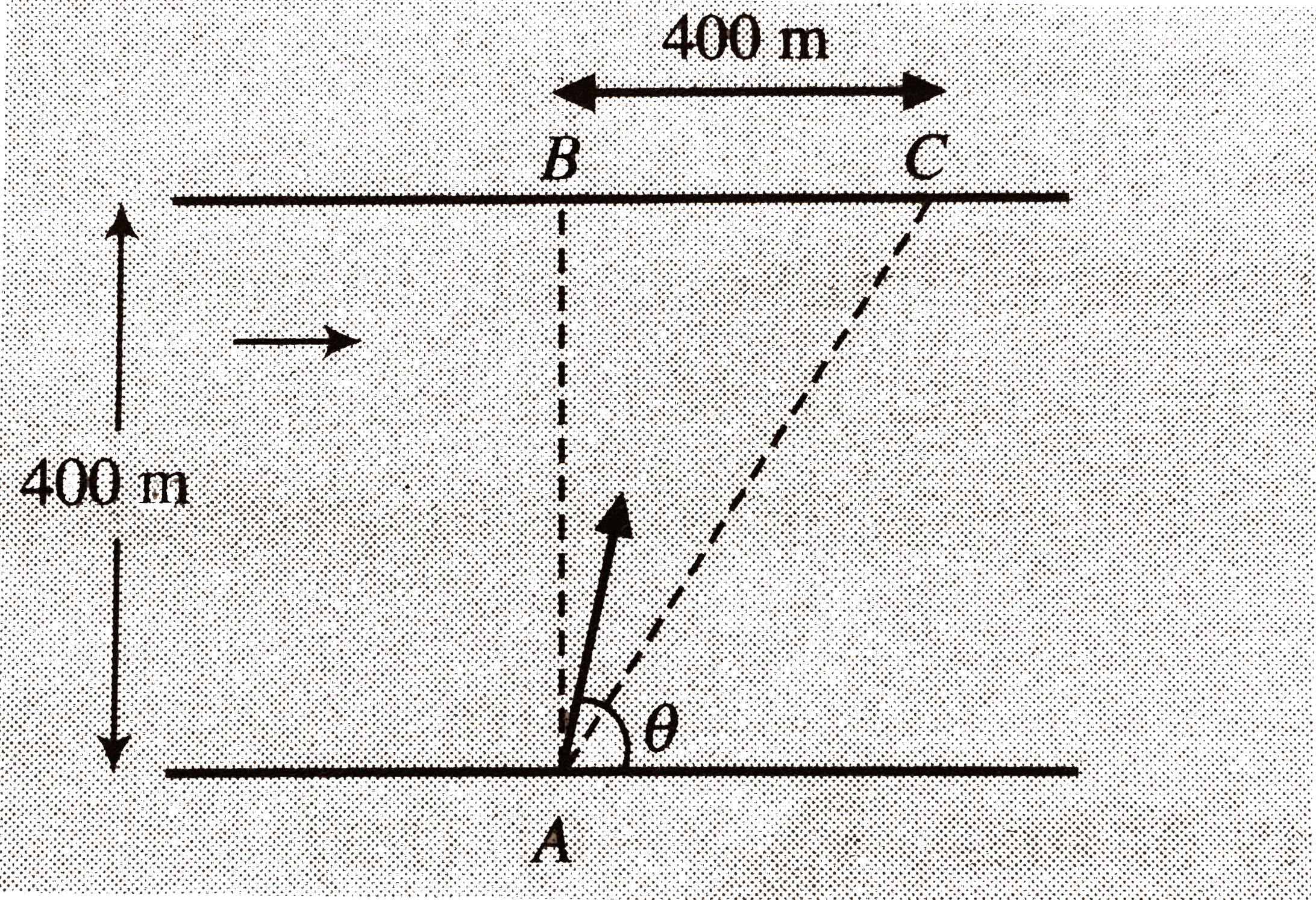 .04:35View Solution
.04:35View SolutionA man wants to swim in a river from `A to B` and back from `B to A` always following line `AB` (Fig. 5.94). The distance between points `A and B` is `S`. The velocity of the river current `v` is constant over the entire width of the river. The line `AB` makes an angle `prop` with the direction of current. The man moves with velocity `u` at angle `beta` to the line `AB`. The man swim to cover distance `AB` and back, find the time taken to complete the journey.
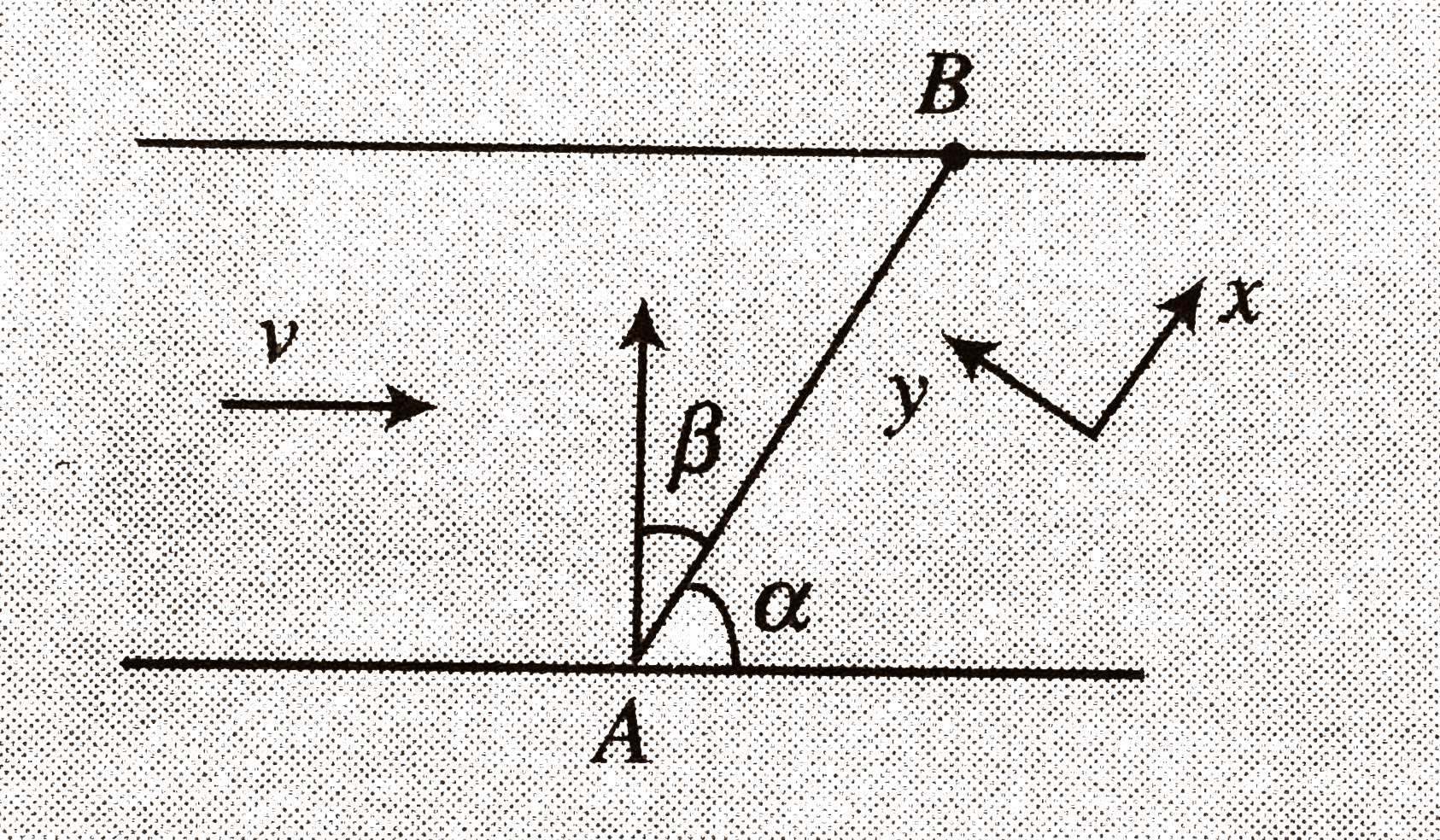 .04:07View Solution
.04:07View SolutionRain is falling vertically with velocity 10m /s and a man is moving with velocity `6 m s^-1`. Find the angle at which the man should hold his umbrella to above getting wet.
03:09View SolutionA man moving with `5 ms^-1` observes rain falling vertically at the rate of `10 m s^-1`. Find the speed and direction of the rain with respect to ground.
03:24View SolutionA standing man observes rain falling with the velocity of `20 m s^-1` at an angle of `30^@` with the vertical.
(a) Find the velocity with which the man should move so that rain appears to fall vertically to him.
Now if he further increases his speed, rain again appears to fall at `30^@` with the vertical. Find his new velocity.04:22View SolutionA person standing on a road has to hold his umbrella at `60^(0)` with the verticcal to keep the rain away. He throws the umbrella an starts running at `20 ms^(-1)`. He finds that rain drops are hitting his head vertically. Find the speed of the rain drops with respect to (a) the road (b) the moving person.
03:22View SolutionA man is coming down an incline of angle `30^@`. When he walks with speed `2(sqrt(3)) m s^-1` he has to keep his umbrella vertical to protect himself from rain. The actual speed of rain is `5 ms^-1`. At angle with vertical should he keep his umbrella when he is at rest so that he does not getb drenched ?
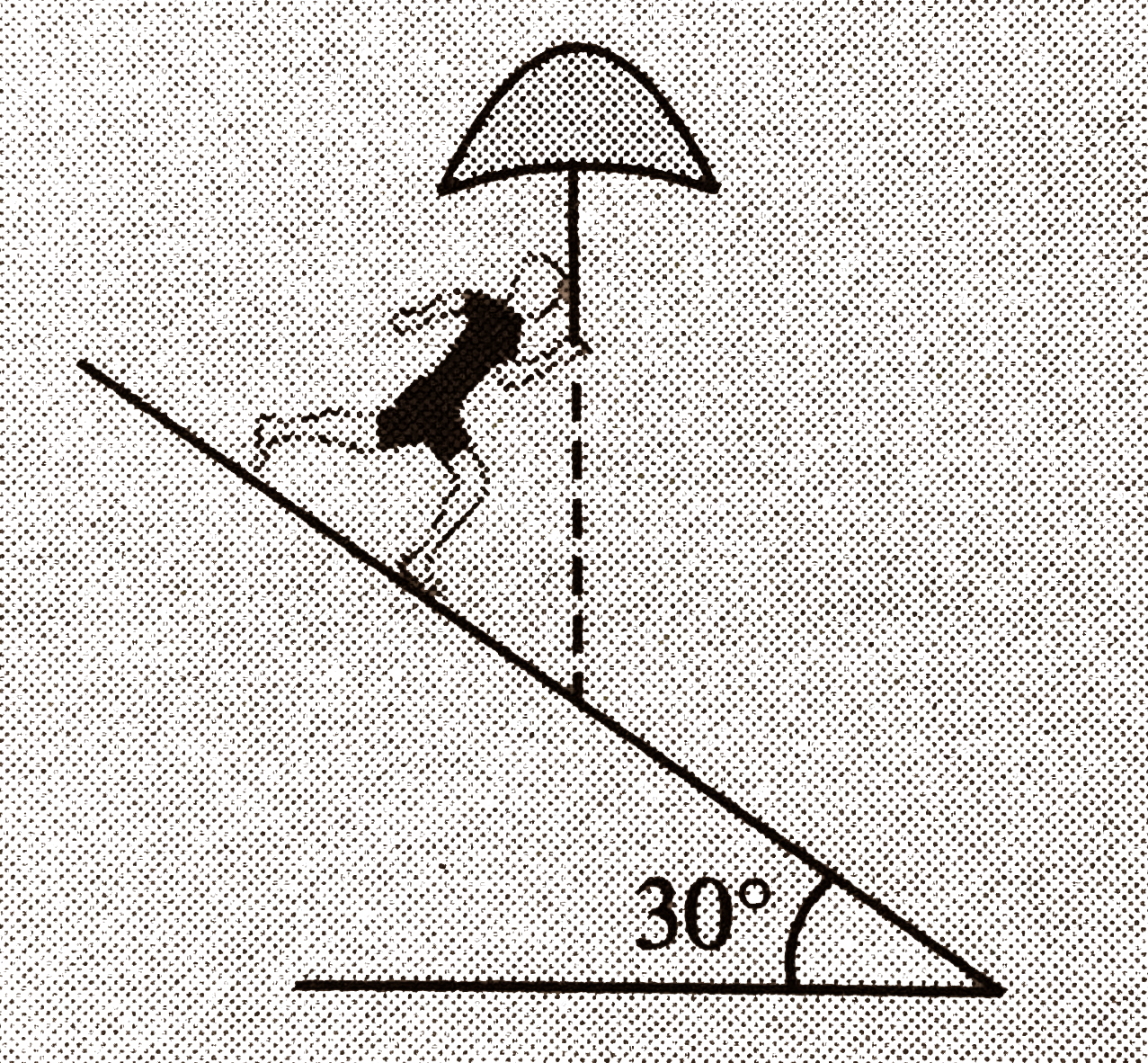 .07:09View Solution
.07:09View SolutionDuring a rainy day, rain is falling vertically with a velocity `2m//s` A boy at rest starts his motion with a constant acceleration of `2m//s^(2)` along a straight road . Find the rate at which the angle of the axis of umbrella with vertical should be changed so that the rain always falls parallel to the axis of the umbrella.
03:45View SolutionAn aeroplane pilot wishes to fly due west A wind of `100 km h^-1` is blowing towards south.
(a) If the speed of the plane (its speed in still air) is `300 km h^-1` in which direction should the pilot head ?
(b) What is the speed of the plane with respect tom ground ? Illustrate with a vector diagram.View SolutionAn aeroplane has a velocity of 110 m/s directed due north and is subjected to a wind blowing from west to east at a speed of 40 m/s . Calculate the actual velocity of the aeroplane relative to the earth .
04:39View Solution`A,B,C, and D` are four trees, located at the vertices of a square (Fig. 5.117). Wind blows from `A to B` with uniform speed. The ratio of times of flight of a bird from `A to B` and from `B to A` is `n`. At what angle should the bird fly from the direction of wind flow, in order that it starts from `A` and
(a) reaches `C`,
(b) reaches `D` ?09:55View SolutionTwo particles are located on a horizontal plane at a distance `60 m`. At `t = 0` both the particles are simultaneously projected at angle `45^@` with velocities `2 ms^-1 and 14 m s^-1`, respectively. Find
(a) Minimum separation between them during motion.
(b) At what time is the separation between them minimum ?
 .06:50View Solution
.06:50View SolutionTwo particles `A and B` are moving with constant velocities `v_1 and v_2`. At `t = 0`, `v_1` makes an angle `theta_0` with the line joining `A and B and v_2` makes an angle `theta_2` with the line joining `A and B`.
(a) Find the condition for `A and B` to collide.
(b) Find the time after which `A and B` will collide if separation between them is d at ` t = 0`.
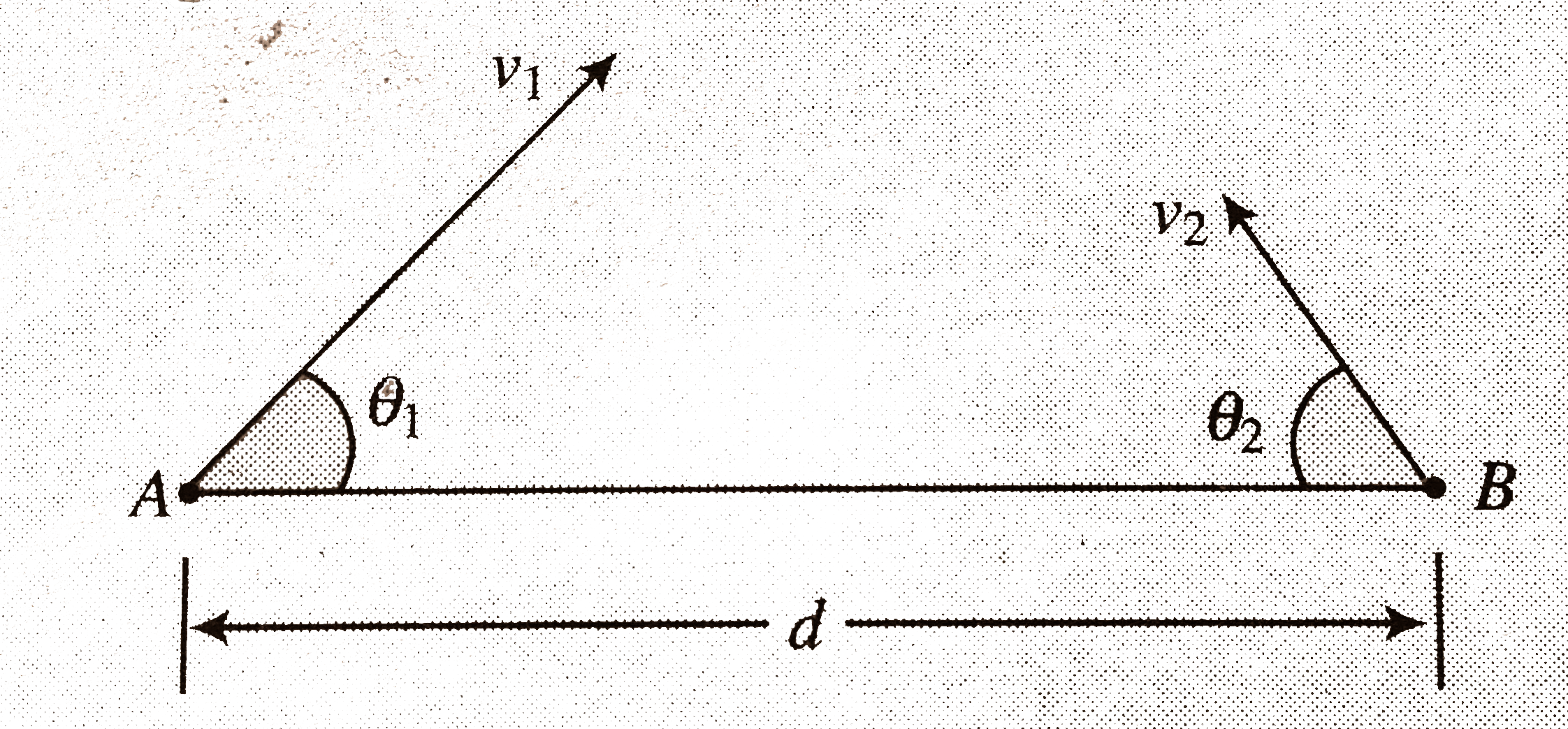 .04:43View Solution
.04:43View SolutionTwo particles `A and B` are moving with constant velocities `v_1 and v_2`. At `t = 0`, `v_1` makes an angle `theta_0` with the line joining `A and B and v_2` makes an angle `theta_2` with the line joining `A and B`.
(a) Find the condition for `A and B` to collide.
(b) Find the time after which `A and B` will collide if separation between them is d at ` t = 0`.
 .04:43View Solution
.04:43View SolutionTwo cars `A and B` are moving west to east and south to north, respectively, along crossroads. A moves with a speed of `20 m s^-1` and is `500 m` away from the point of intersection of cross roads and `B` moves with a speed of `15 ms^-1` and is `400 m` away from the point of intersection of cross roads. Find the shortest distance between them.
04:19View SolutionTwo particles `A and B` are moving with uniform velocity as shown in (Fig. 5.130) given below at `t = 0`.
(a) Will the two particles collide ?
(b) Find out the shortest distance between two particles.
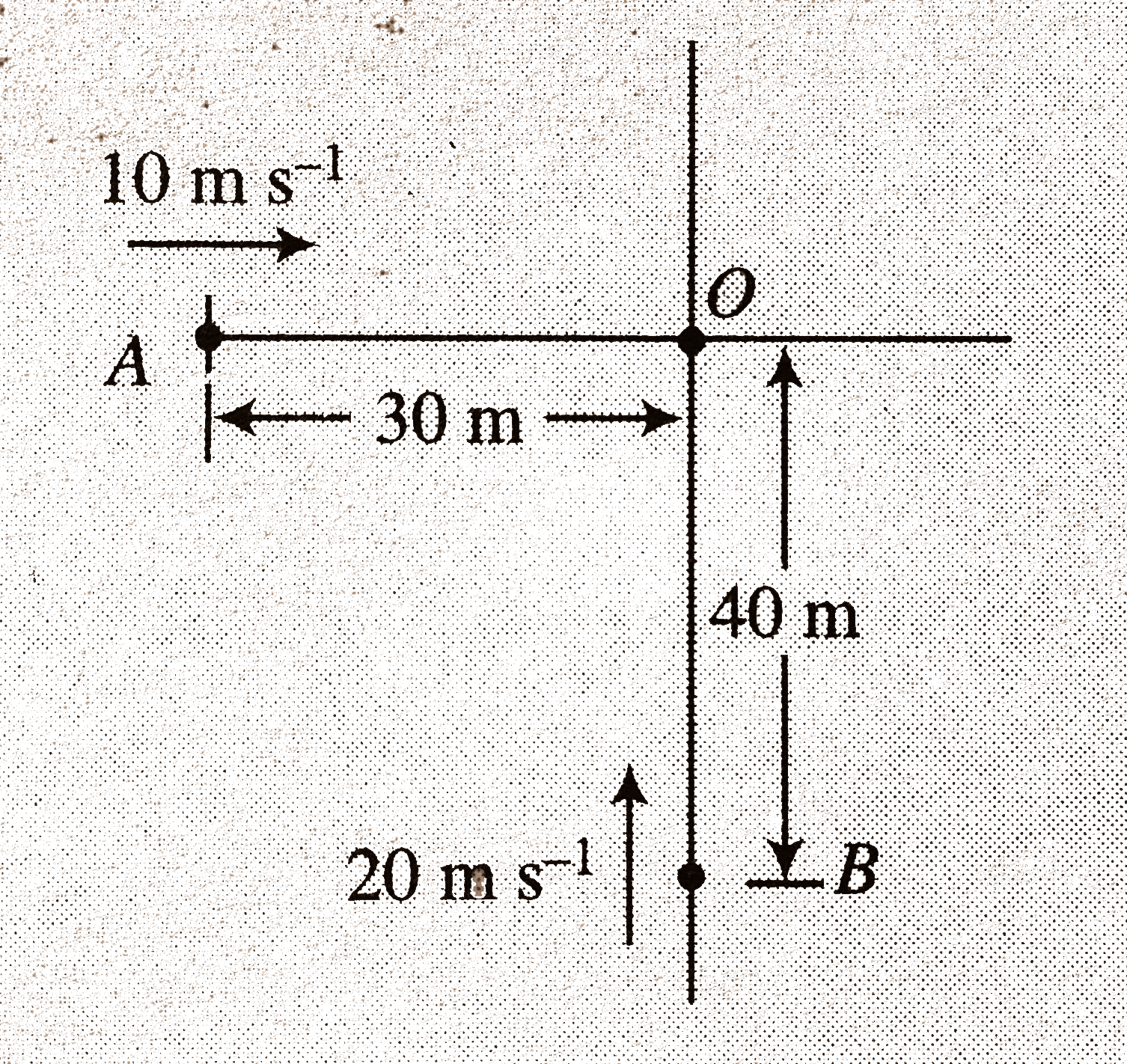 .04:32View Solution
.04:32View SolutionThree particles A, B and C are situated at the vertices of an equilateral triangle ABC of side d at time `t=0.` Each of the particles moves with constant speed v. A always has its velocity along AB, B along BC and C along CA. At what time will the particles meet each other?
02:51View SolutionIn a clock, what is the time period of meeting of the minute hand and the second hand ?
04:08View SolutionA particle moves in a circle of radius 2 cm at a speed given by v = 4 t, where v is in `cms^(-1)` and t in second.
(i) Find the tangential acceleration `at=1 s.
(ii) Find total acceleration at t = 1 s.03:21View SolutionA particle moves on a circle of radius `r` with centripetal acceleration as function of time as `a_c = k^2 r t^2`, where `k` is a positive constant. Find the following quantities as function of time at an instant :
(a) The speed of the particle
(b) The tangential acceleration of the particle
( c) The resultant acceleration, and
(d) Angle made by the resultant acceleration with tangential acceleration direction.03:09View SolutionA particle moves in a circular path such that its speed `1v` varies with distance `s` as `v = sqrt(s)`, where `prop` is a positive constant. Find the acceleration of the particle after traversing a distance `s`.
02:57View SolutionThe tangential acceleration of a particle moving in a circular path of radius `5 cm` is `2 m s^-2`. The angular velocity of the particle increases from `10 rad s^-1` to `20 rad s^-1` during some time. Find
(a) this duration od time and
(b) the number of revolutions completed during this time.03:37View SolutionA fan is rotating with angular velocity `100 rev s^-1`. Then is switched off. It takes `5 min`to stop.
(a) Find the total number of revolution made before the fan stops. (assume uniform angular retardation).
(b) Find the value of angular retardation.
( c) Find the average angular velocity during this interval.03:20View SolutionTwo particles `A and B` move on a circle Initially, particles `A and B` are diagonally opposite to each other. Particle `A` moves with angular velocity `pi rad s^-1` and angular acceleration `pi//2 rad s^-2` and particle `B` moves with constant angular velocity `2 pi rad s^-2`. Find the time after which both the particlsd `A nad B` will collide.
04:07View SolutionA stone tied to an inextensible string of length `l = 1 m` is kept horizontal. If it is released, find the angular speed of the stone when the string makes an angle `theta = 30^@` with horizontal.
02:15View SolutionFind the angular velocity of `A` with respect to `B` in (Fig. 5.156).
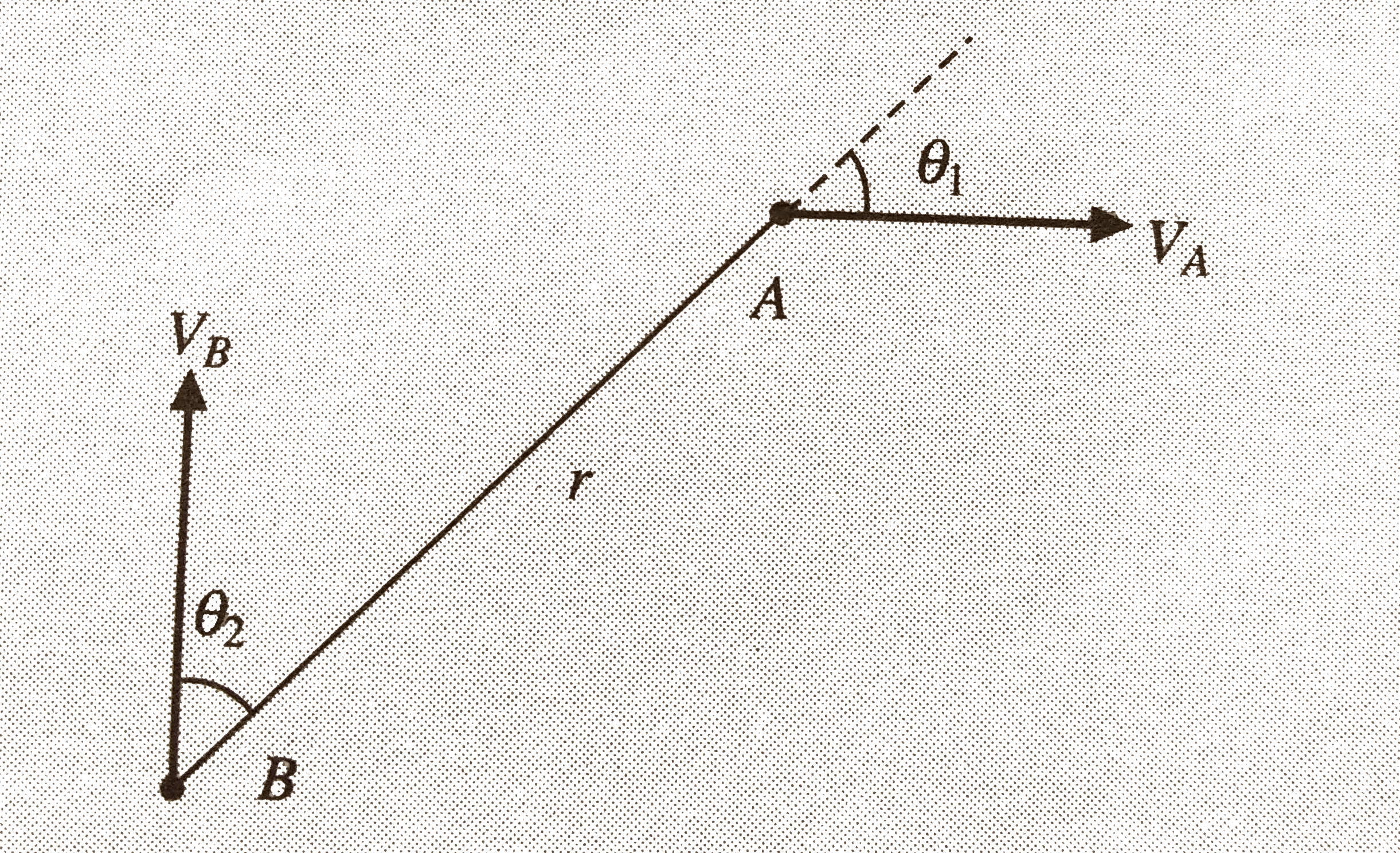 .02:57View Solution
.02:57View SolutionTwo particles P and Q are moving as shown in the figure. At this moment of time the angular speed of P w.r.t. Q is
 03:48View Solution
03:48View SolutionA particle is projected at angle `theta` with horizontal with velocity `v_0 at t = 0`. Find
(a) tangential and normal acceleration of the particle at `t = 0` and at highest point of its trajectory.
(b) the radius of curvature `att = 0` and highest point.
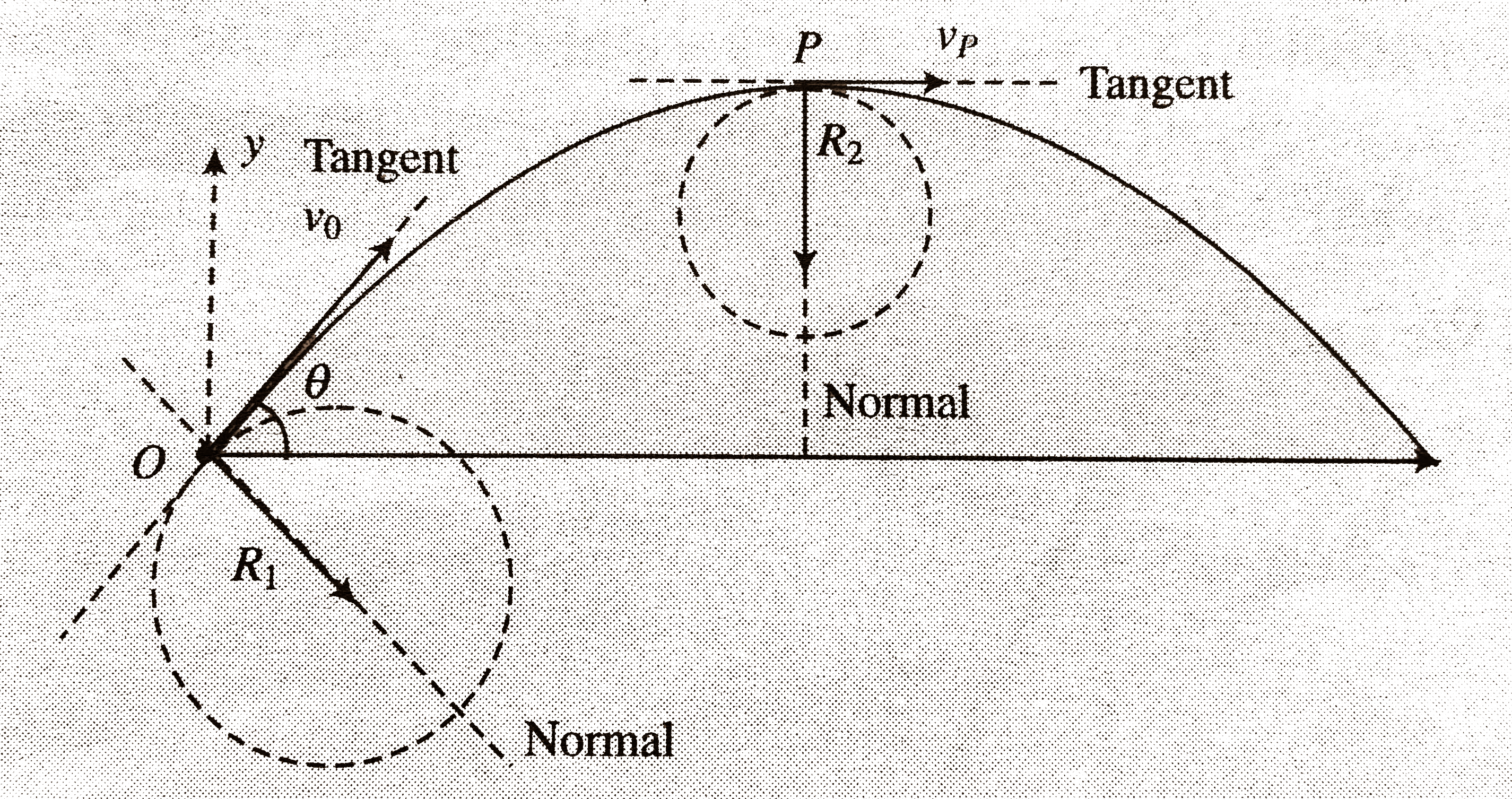 .04:03View Solution
.04:03View Solution
Illustration questions and complete solutions for chapter KINEMATICS-2 of CENGAGE PHYSICS (ENGLISH) of Class 11
